HI6008 Assessment 2: Training and Development Programs at Coles
VerifiedAdded on 2024/05/31
|19
|2088
|327
Report
AI Summary
This report assesses the impact of training and development programs on employee performance, focusing on Coles Supermarket. It begins by outlining project objectives, including analyzing the effect of training on employee performance, ascertaining training needs, and determining the relationship between training and skills development. The report includes a literature review examining the connection between training satisfaction and employee performance improvement, the relevance of training and development for executive-level employees, and the effectiveness of training programs in improving faculty performance. Research questions and hypotheses are presented, followed by a discussion of research design and methodology, incorporating both qualitative and quantitative approaches, including a questionnaire. The findings indicate that differentiated training and development programs are effective based on job roles, enhancing employee performance. Limitations include financial constraints. The report concludes that training and development programs are significant for employees to learn workings and techniques to improve their performance, emphasizing the need for tailored programs based on job roles.
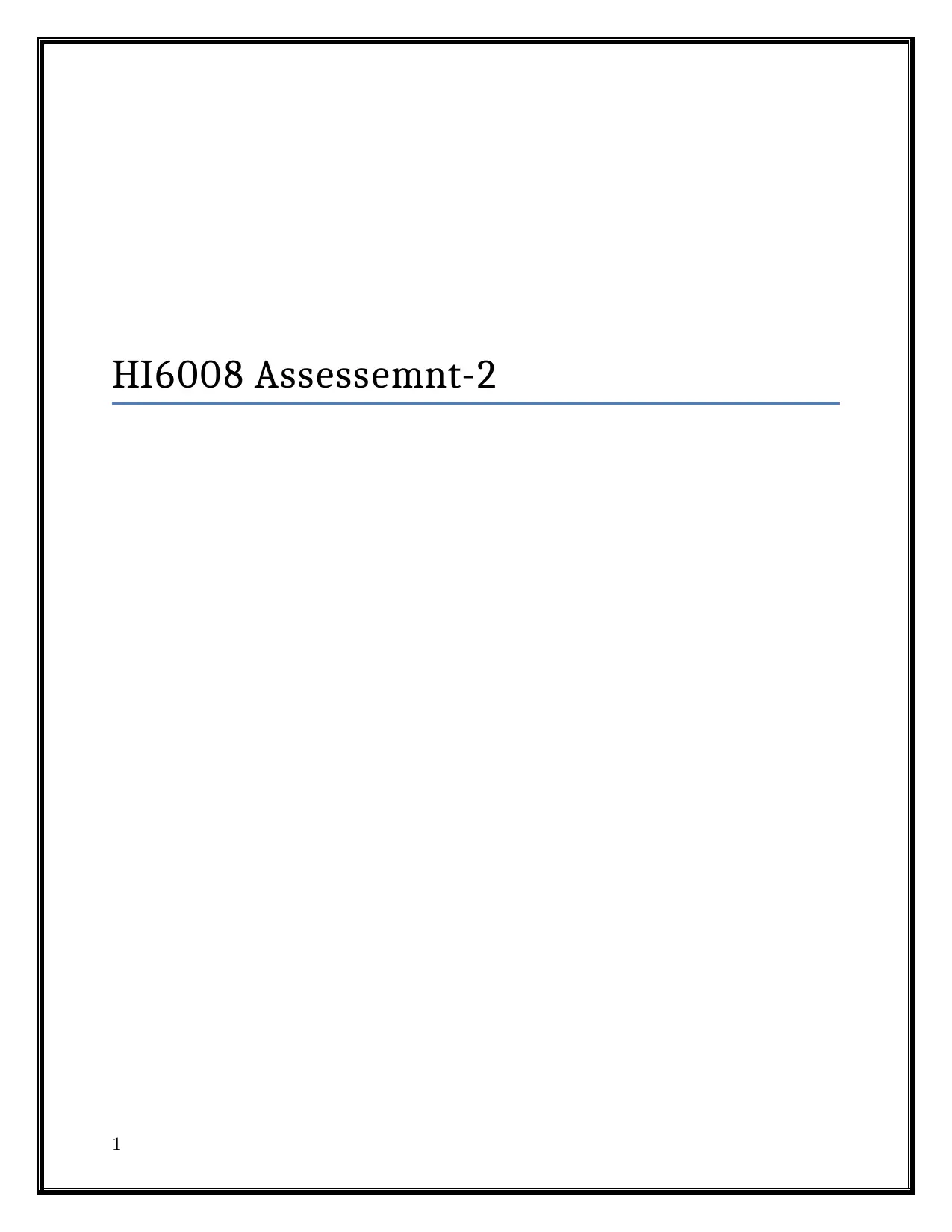
HI6008 Assessemnt-2
1
1
Paraphrase This Document
Need a fresh take? Get an instant paraphrase of this document with our AI Paraphraser
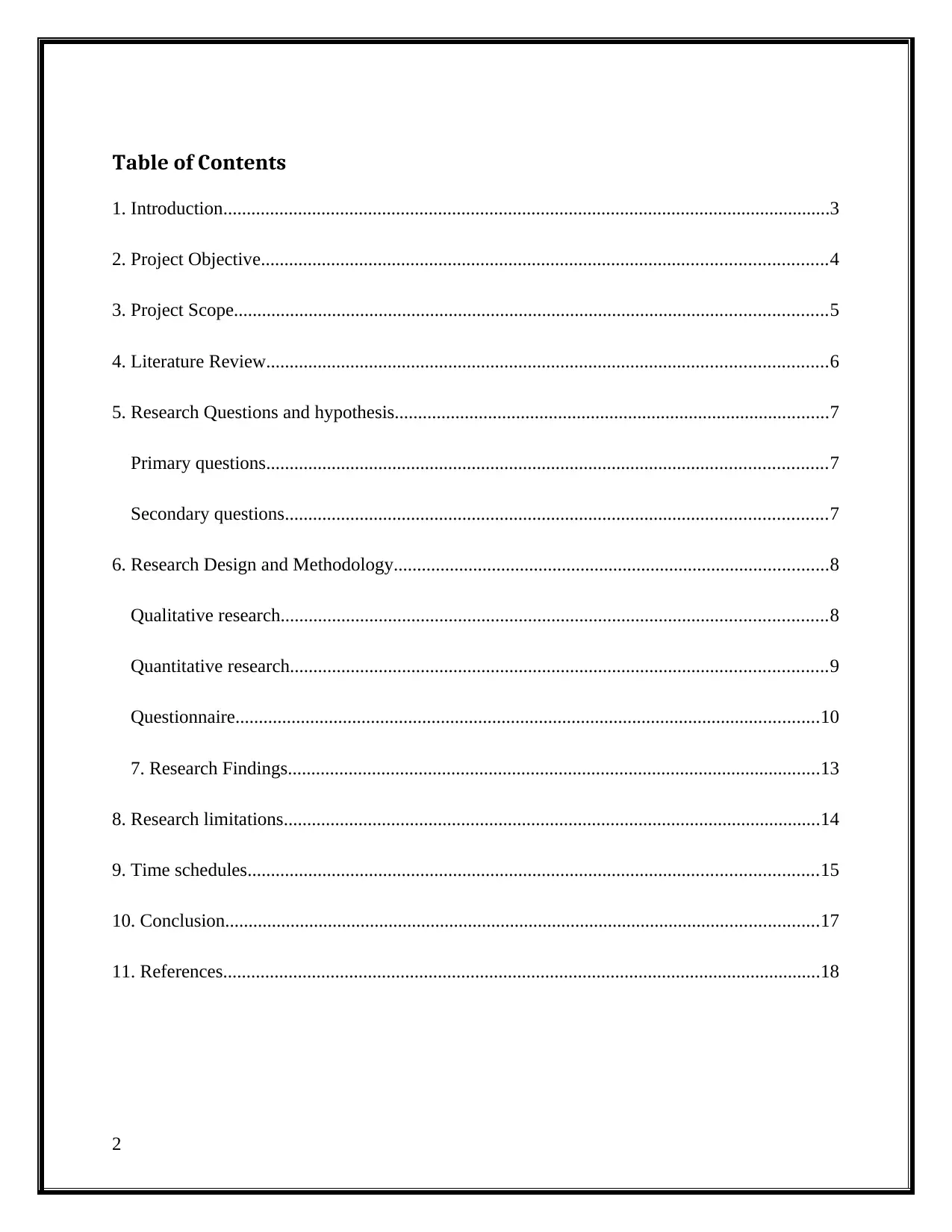
Table of Contents
1. Introduction..................................................................................................................................3
2. Project Objective.........................................................................................................................4
3. Project Scope...............................................................................................................................5
4. Literature Review........................................................................................................................6
5. Research Questions and hypothesis.............................................................................................7
Primary questions........................................................................................................................7
Secondary questions....................................................................................................................7
6. Research Design and Methodology.............................................................................................8
Qualitative research.....................................................................................................................8
Quantitative research...................................................................................................................9
Questionnaire.............................................................................................................................10
7. Research Findings..................................................................................................................13
8. Research limitations...................................................................................................................14
9. Time schedules..........................................................................................................................15
10. Conclusion...............................................................................................................................17
11. References................................................................................................................................18
2
1. Introduction..................................................................................................................................3
2. Project Objective.........................................................................................................................4
3. Project Scope...............................................................................................................................5
4. Literature Review........................................................................................................................6
5. Research Questions and hypothesis.............................................................................................7
Primary questions........................................................................................................................7
Secondary questions....................................................................................................................7
6. Research Design and Methodology.............................................................................................8
Qualitative research.....................................................................................................................8
Quantitative research...................................................................................................................9
Questionnaire.............................................................................................................................10
7. Research Findings..................................................................................................................13
8. Research limitations...................................................................................................................14
9. Time schedules..........................................................................................................................15
10. Conclusion...............................................................................................................................17
11. References................................................................................................................................18
2
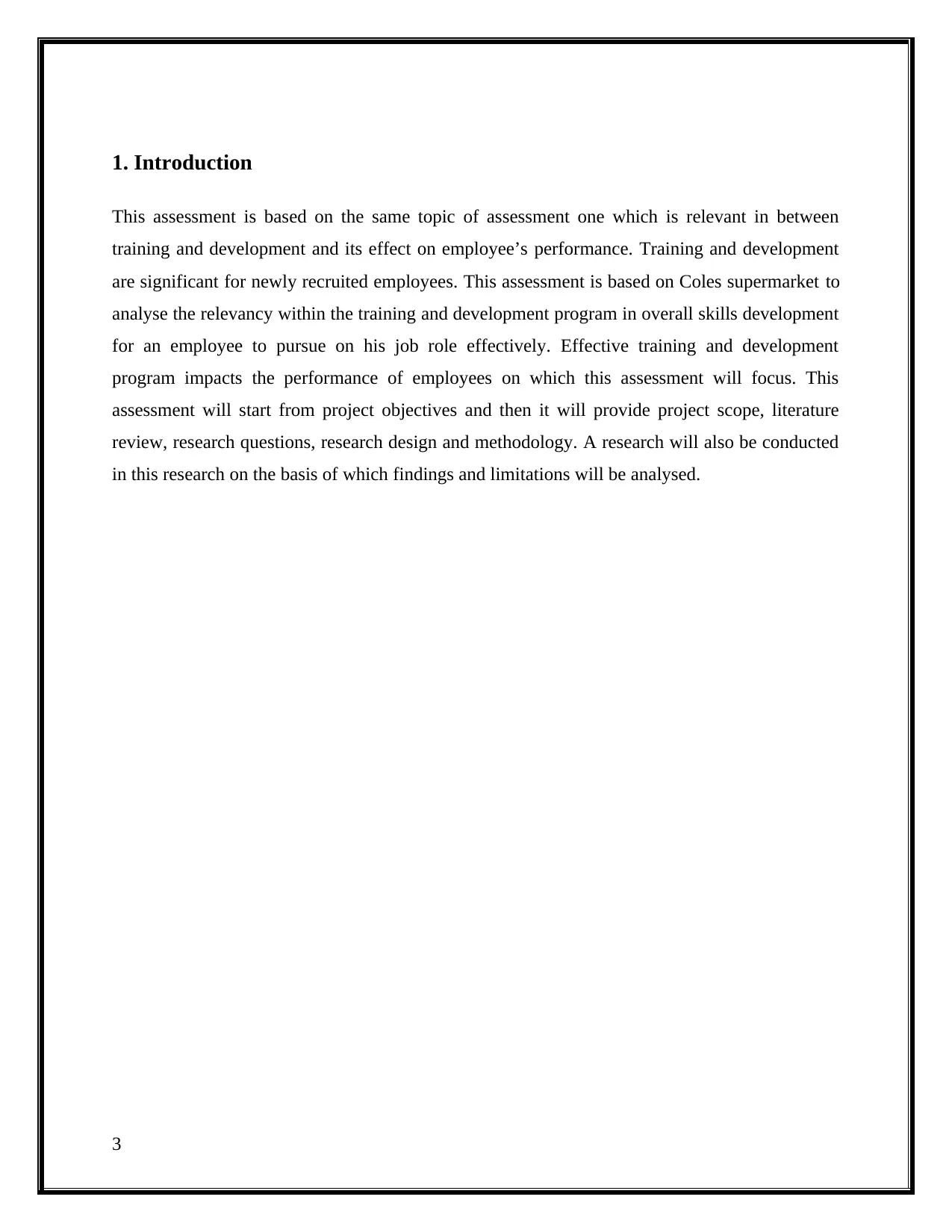
1. Introduction
This assessment is based on the same topic of assessment one which is relevant in between
training and development and its effect on employee’s performance. Training and development
are significant for newly recruited employees. This assessment is based on Coles supermarket to
analyse the relevancy within the training and development program in overall skills development
for an employee to pursue on his job role effectively. Effective training and development
program impacts the performance of employees on which this assessment will focus. This
assessment will start from project objectives and then it will provide project scope, literature
review, research questions, research design and methodology. A research will also be conducted
in this research on the basis of which findings and limitations will be analysed.
3
This assessment is based on the same topic of assessment one which is relevant in between
training and development and its effect on employee’s performance. Training and development
are significant for newly recruited employees. This assessment is based on Coles supermarket to
analyse the relevancy within the training and development program in overall skills development
for an employee to pursue on his job role effectively. Effective training and development
program impacts the performance of employees on which this assessment will focus. This
assessment will start from project objectives and then it will provide project scope, literature
review, research questions, research design and methodology. A research will also be conducted
in this research on the basis of which findings and limitations will be analysed.
3
⊘ This is a preview!⊘
Do you want full access?
Subscribe today to unlock all pages.

Trusted by 1+ million students worldwide
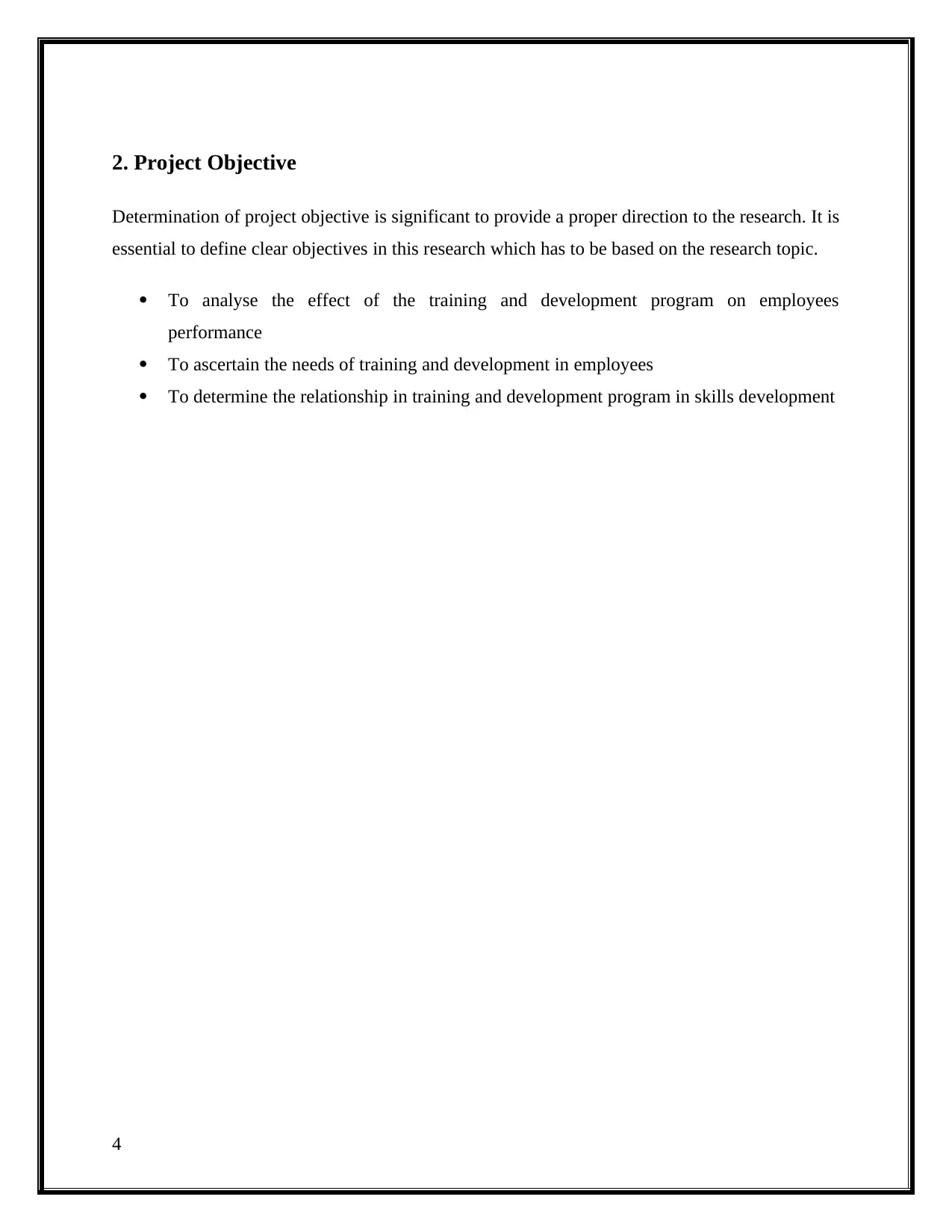
2. Project Objective
Determination of project objective is significant to provide a proper direction to the research. It is
essential to define clear objectives in this research which has to be based on the research topic.
To analyse the effect of the training and development program on employees
performance
To ascertain the needs of training and development in employees
To determine the relationship in training and development program in skills development
4
Determination of project objective is significant to provide a proper direction to the research. It is
essential to define clear objectives in this research which has to be based on the research topic.
To analyse the effect of the training and development program on employees
performance
To ascertain the needs of training and development in employees
To determine the relationship in training and development program in skills development
4
Paraphrase This Document
Need a fresh take? Get an instant paraphrase of this document with our AI Paraphraser

3. Project Scope
This project widely scoped on the organisations which are using the training and development
programmes to develop skills in employees. This project is based to analyse the relevance in
training and development program. This research will use different kinds of literature which are
based on this research topic to analyse the views of different authors on this topic.
5
This project widely scoped on the organisations which are using the training and development
programmes to develop skills in employees. This project is based to analyse the relevance in
training and development program. This research will use different kinds of literature which are
based on this research topic to analyse the views of different authors on this topic.
5
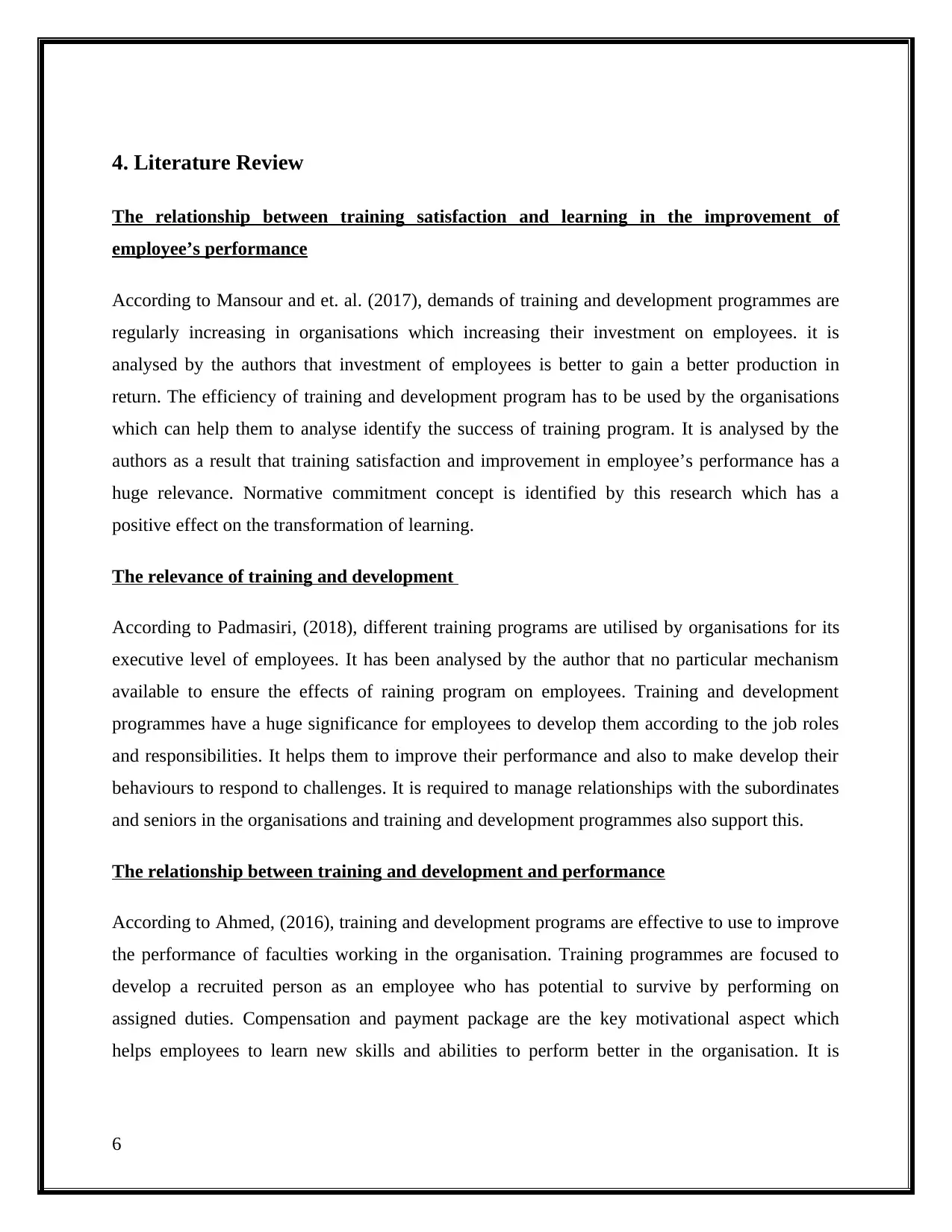
4. Literature Review
The relationship between training satisfaction and learning in the improvement of
employee’s performance
According to Mansour and et. al. (2017), demands of training and development programmes are
regularly increasing in organisations which increasing their investment on employees. it is
analysed by the authors that investment of employees is better to gain a better production in
return. The efficiency of training and development program has to be used by the organisations
which can help them to analyse identify the success of training program. It is analysed by the
authors as a result that training satisfaction and improvement in employee’s performance has a
huge relevance. Normative commitment concept is identified by this research which has a
positive effect on the transformation of learning.
The relevance of training and development
According to Padmasiri, (2018), different training programs are utilised by organisations for its
executive level of employees. It has been analysed by the author that no particular mechanism
available to ensure the effects of raining program on employees. Training and development
programmes have a huge significance for employees to develop them according to the job roles
and responsibilities. It helps them to improve their performance and also to make develop their
behaviours to respond to challenges. It is required to manage relationships with the subordinates
and seniors in the organisations and training and development programmes also support this.
The relationship between training and development and performance
According to Ahmed, (2016), training and development programs are effective to use to improve
the performance of faculties working in the organisation. Training programmes are focused to
develop a recruited person as an employee who has potential to survive by performing on
assigned duties. Compensation and payment package are the key motivational aspect which
helps employees to learn new skills and abilities to perform better in the organisation. It is
6
The relationship between training satisfaction and learning in the improvement of
employee’s performance
According to Mansour and et. al. (2017), demands of training and development programmes are
regularly increasing in organisations which increasing their investment on employees. it is
analysed by the authors that investment of employees is better to gain a better production in
return. The efficiency of training and development program has to be used by the organisations
which can help them to analyse identify the success of training program. It is analysed by the
authors as a result that training satisfaction and improvement in employee’s performance has a
huge relevance. Normative commitment concept is identified by this research which has a
positive effect on the transformation of learning.
The relevance of training and development
According to Padmasiri, (2018), different training programs are utilised by organisations for its
executive level of employees. It has been analysed by the author that no particular mechanism
available to ensure the effects of raining program on employees. Training and development
programmes have a huge significance for employees to develop them according to the job roles
and responsibilities. It helps them to improve their performance and also to make develop their
behaviours to respond to challenges. It is required to manage relationships with the subordinates
and seniors in the organisations and training and development programmes also support this.
The relationship between training and development and performance
According to Ahmed, (2016), training and development programs are effective to use to improve
the performance of faculties working in the organisation. Training programmes are focused to
develop a recruited person as an employee who has potential to survive by performing on
assigned duties. Compensation and payment package are the key motivational aspect which
helps employees to learn new skills and abilities to perform better in the organisation. It is
6
⊘ This is a preview!⊘
Do you want full access?
Subscribe today to unlock all pages.

Trusted by 1+ million students worldwide

analysed that training and development programs contain equal significance of compensation to
motivate people to perform better.
7
motivate people to perform better.
7
Paraphrase This Document
Need a fresh take? Get an instant paraphrase of this document with our AI Paraphraser

5. Research Questions and hypothesis
It is essential to design research hypothesis to develop a vision to conduct this research
effectively. It has been analysed by the literature review that training and development programs
have a huge significance in the employee’s performance.
H1: Training and development both are containing equal significance in employee’s
performance and creates an equal effect on employee’s performance.
H2: Newly recruited and experienced employees both are having needs of training and
development programmes time by time for performance improvement.
Primary questions
Question 1: Does training and development program contain equal effect on employee’s
performance?
Secondary questions
Question 1: Is it essential to use a particular training method for enhancement in
employee’s performance?
Question 2: Is training and development program for employee’s have a direct
relationship and impact on the employee’s performance?
8
It is essential to design research hypothesis to develop a vision to conduct this research
effectively. It has been analysed by the literature review that training and development programs
have a huge significance in the employee’s performance.
H1: Training and development both are containing equal significance in employee’s
performance and creates an equal effect on employee’s performance.
H2: Newly recruited and experienced employees both are having needs of training and
development programmes time by time for performance improvement.
Primary questions
Question 1: Does training and development program contain equal effect on employee’s
performance?
Secondary questions
Question 1: Is it essential to use a particular training method for enhancement in
employee’s performance?
Question 2: Is training and development program for employee’s have a direct
relationship and impact on the employee’s performance?
8

6. Research Design and Methodology
Research design
Research design represents the design and structure of activities which has to be done to conduct
a research (Lewis, 2015). A proper research design supports in an effective execution of research
to attain the research objectives.
Methodology
It is essential before conducting research to determine research methodologies on the basis of
which whole research will be conducted. It is essential to determine the research approach in
which qualitative and quantitative mainly considered. Qualitative research is based on gathering
reviews, suggestions and perception of different people by the use of an effective instrument for
data gathering (Neuman, 2013). Interview and observation methods are used to conduct the
qualitative research on a specific research topic. The quantitative research approach is focused to
collect on the numerical data which can help to the researcher to get an exact outcome on the
research topic. A large sample size is used to conduct quantitative research approach. The
questionnaire is a general data collection method used in quantitative research approach to
gathering data and statistics.
Qualitative research
This research approach is focused to collect reviews and suggestions of targeted people on the
research topic. The process to conduct qualitative research is given below:
Research aims and objectives
Research design
Topics to collect data
Appropriate data collection method (Interview, focus group, observation group etc.)
Appropriate data sampling techniques (Probabilistic and non-probabilistic)
Sample size (Smaller sample size to manage reliability and authentication in research)
Data analysis
9
Research design
Research design represents the design and structure of activities which has to be done to conduct
a research (Lewis, 2015). A proper research design supports in an effective execution of research
to attain the research objectives.
Methodology
It is essential before conducting research to determine research methodologies on the basis of
which whole research will be conducted. It is essential to determine the research approach in
which qualitative and quantitative mainly considered. Qualitative research is based on gathering
reviews, suggestions and perception of different people by the use of an effective instrument for
data gathering (Neuman, 2013). Interview and observation methods are used to conduct the
qualitative research on a specific research topic. The quantitative research approach is focused to
collect on the numerical data which can help to the researcher to get an exact outcome on the
research topic. A large sample size is used to conduct quantitative research approach. The
questionnaire is a general data collection method used in quantitative research approach to
gathering data and statistics.
Qualitative research
This research approach is focused to collect reviews and suggestions of targeted people on the
research topic. The process to conduct qualitative research is given below:
Research aims and objectives
Research design
Topics to collect data
Appropriate data collection method (Interview, focus group, observation group etc.)
Appropriate data sampling techniques (Probabilistic and non-probabilistic)
Sample size (Smaller sample size to manage reliability and authentication in research)
Data analysis
9
⊘ This is a preview!⊘
Do you want full access?
Subscribe today to unlock all pages.

Trusted by 1+ million students worldwide
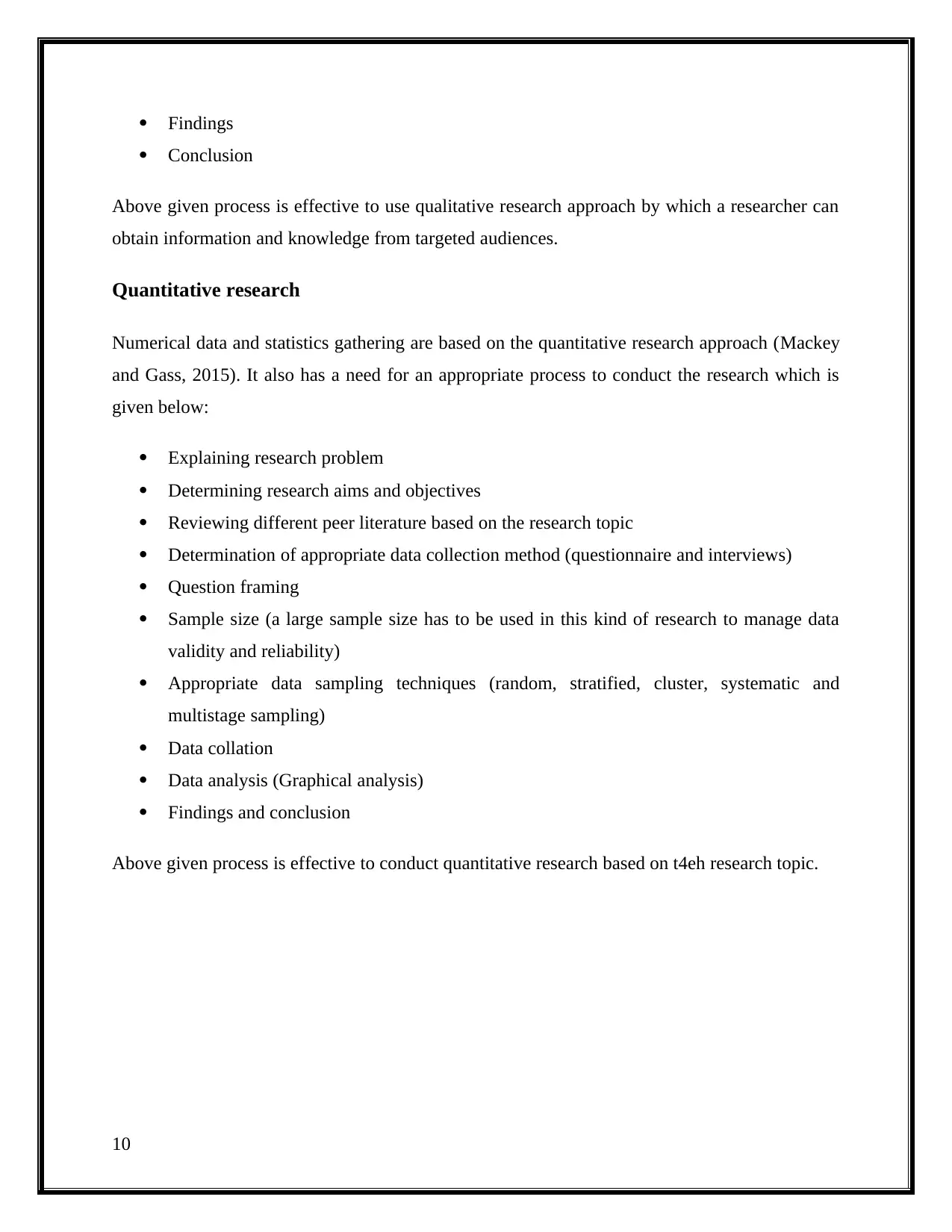
Findings
Conclusion
Above given process is effective to use qualitative research approach by which a researcher can
obtain information and knowledge from targeted audiences.
Quantitative research
Numerical data and statistics gathering are based on the quantitative research approach (Mackey
and Gass, 2015). It also has a need for an appropriate process to conduct the research which is
given below:
Explaining research problem
Determining research aims and objectives
Reviewing different peer literature based on the research topic
Determination of appropriate data collection method (questionnaire and interviews)
Question framing
Sample size (a large sample size has to be used in this kind of research to manage data
validity and reliability)
Appropriate data sampling techniques (random, stratified, cluster, systematic and
multistage sampling)
Data collation
Data analysis (Graphical analysis)
Findings and conclusion
Above given process is effective to conduct quantitative research based on t4eh research topic.
10
Conclusion
Above given process is effective to use qualitative research approach by which a researcher can
obtain information and knowledge from targeted audiences.
Quantitative research
Numerical data and statistics gathering are based on the quantitative research approach (Mackey
and Gass, 2015). It also has a need for an appropriate process to conduct the research which is
given below:
Explaining research problem
Determining research aims and objectives
Reviewing different peer literature based on the research topic
Determination of appropriate data collection method (questionnaire and interviews)
Question framing
Sample size (a large sample size has to be used in this kind of research to manage data
validity and reliability)
Appropriate data sampling techniques (random, stratified, cluster, systematic and
multistage sampling)
Data collation
Data analysis (Graphical analysis)
Findings and conclusion
Above given process is effective to conduct quantitative research based on t4eh research topic.
10
Paraphrase This Document
Need a fresh take? Get an instant paraphrase of this document with our AI Paraphraser
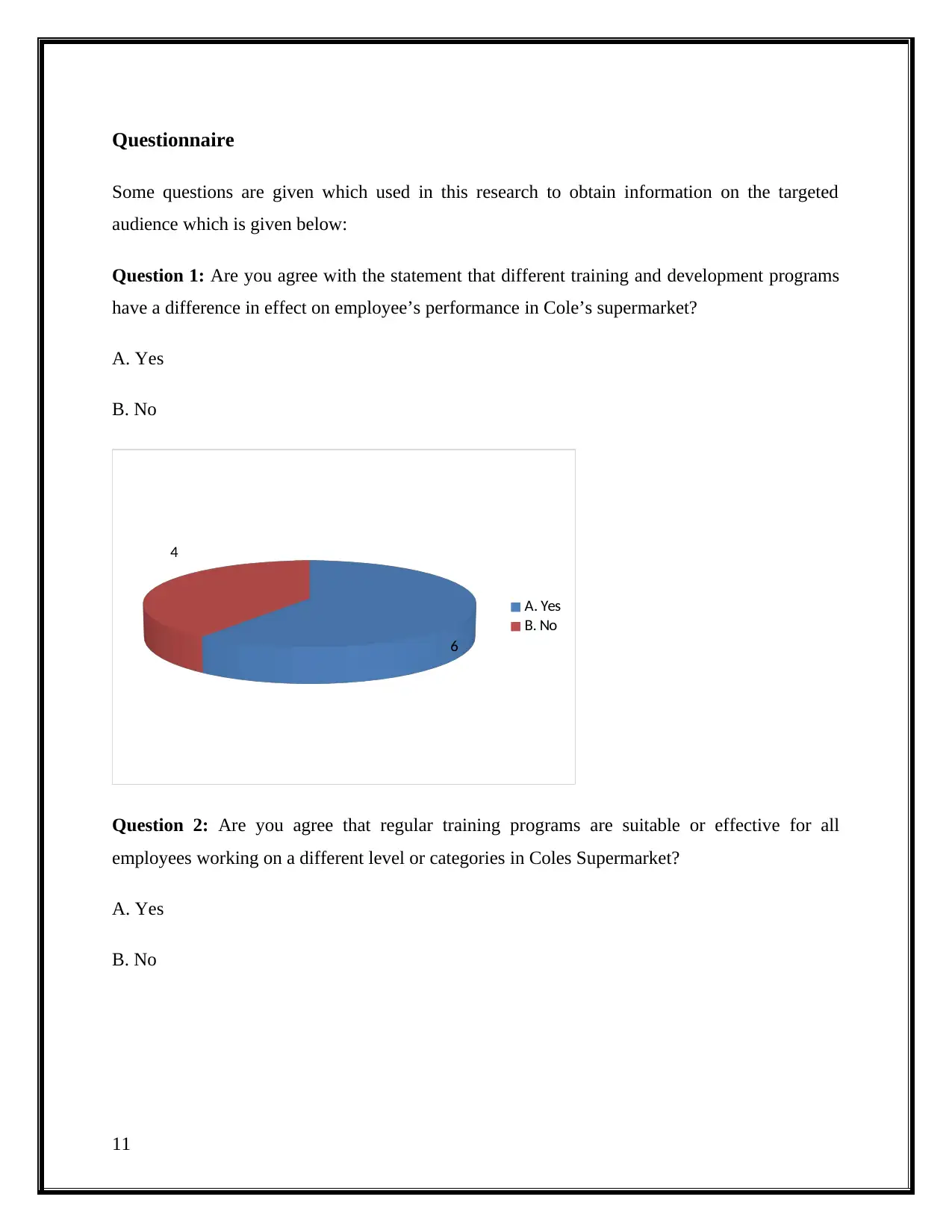
Questionnaire
Some questions are given which used in this research to obtain information on the targeted
audience which is given below:
Question 1: Are you agree with the statement that different training and development programs
have a difference in effect on employee’s performance in Cole’s supermarket?
A. Yes
B. No
6
4
A. Yes
B. No
Question 2: Are you agree that regular training programs are suitable or effective for all
employees working on a different level or categories in Coles Supermarket?
A. Yes
B. No
11
Some questions are given which used in this research to obtain information on the targeted
audience which is given below:
Question 1: Are you agree with the statement that different training and development programs
have a difference in effect on employee’s performance in Cole’s supermarket?
A. Yes
B. No
6
4
A. Yes
B. No
Question 2: Are you agree that regular training programs are suitable or effective for all
employees working on a different level or categories in Coles Supermarket?
A. Yes
B. No
11
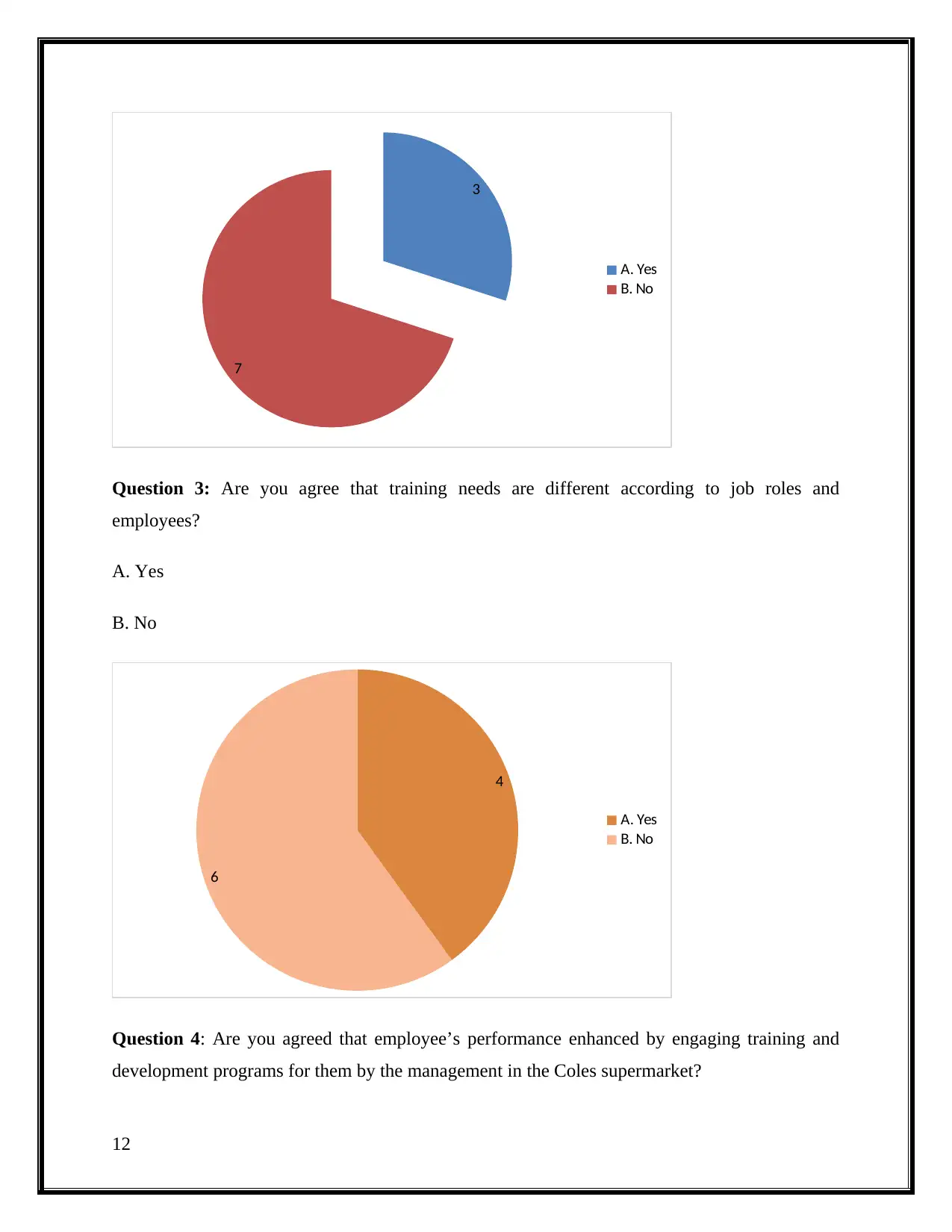
3
7
A. Yes
B. No
Question 3: Are you agree that training needs are different according to job roles and
employees?
A. Yes
B. No
4
6
A. Yes
B. No
Question 4: Are you agreed that employee’s performance enhanced by engaging training and
development programs for them by the management in the Coles supermarket?
12
7
A. Yes
B. No
Question 3: Are you agree that training needs are different according to job roles and
employees?
A. Yes
B. No
4
6
A. Yes
B. No
Question 4: Are you agreed that employee’s performance enhanced by engaging training and
development programs for them by the management in the Coles supermarket?
12
⊘ This is a preview!⊘
Do you want full access?
Subscribe today to unlock all pages.

Trusted by 1+ million students worldwide
1 out of 19
Related Documents
Your All-in-One AI-Powered Toolkit for Academic Success.
+13062052269
info@desklib.com
Available 24*7 on WhatsApp / Email
![[object Object]](/_next/static/media/star-bottom.7253800d.svg)
Unlock your academic potential
Copyright © 2020–2025 A2Z Services. All Rights Reserved. Developed and managed by ZUCOL.





